Indians of Canada Pavilion, Expo 67 (1967)
by Magdalena Miłosz
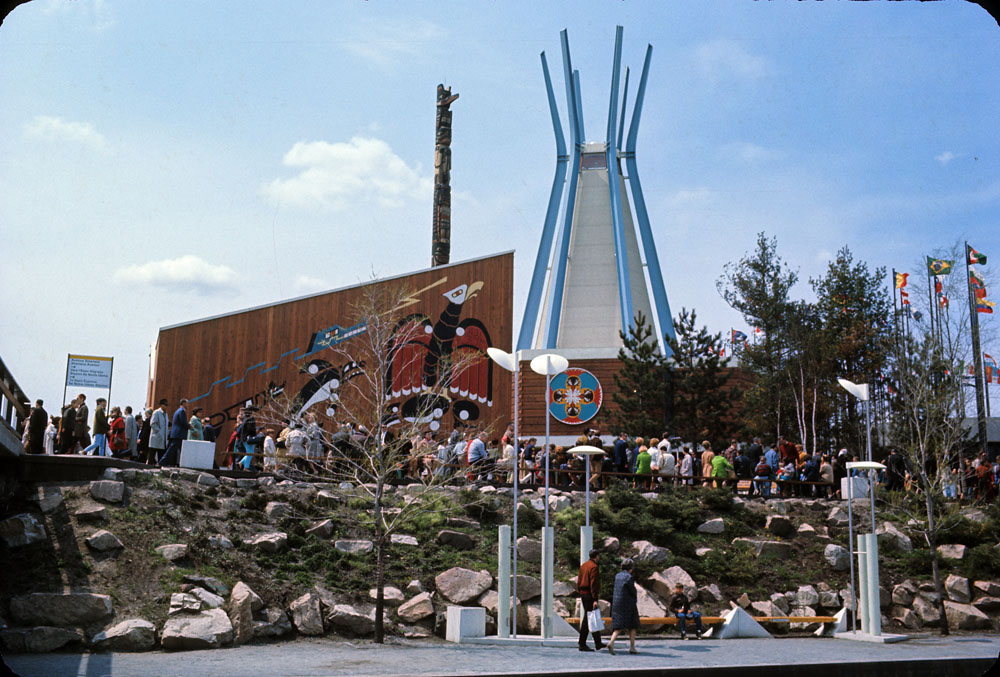
The 1967 International and Universal Exposition in Montreal, known as Expo 67, served as the centerpiece of Canada’s Centennial celebrations. Under the theme “Man and His World,” the exhibition dazzled over 50 million visitors with 90 pavilions showcasing feats of technology and displays by 60 participating nations. But the late 1960s was a time of great social change, and not all corners of Expo 67 shared in the fair’s prevailing mood of optimism. Whereas most pavilions exhibited laudatory images of nationalism, the “Indians of Canada” Pavilion—which represented diverse First Nations from across the country—employed the critical tone of global independence, decolonization, and civil rights movements of the time. Likewise, the pavilion’s fusion of Indigenous and settler-colonial elements—represented by its art and architecture, respectively—demonstrated the ongoing control of the Canadian government alongside the resistance of First Nations.
The “Indians of Canada” Pavilion at Expo 67
At the south end of the exhibition grounds on Île Notre-Dame (an artificial island built using fill from the construction of the city’s subway), a 100-foot-tall, six-sided, tipi-like structure rose like a beacon. With “poles” made of steel beams painted bright blue, and white vinyl cladding, the Indians of Canada Pavilion attracted visitors with a modernist interpretation of an instantly recognizable Indigenous architectural form. Although tipis have historically been and continue to be built by Indigenous Peoples of the Plains, they have also been typecast as a pan-Indigenous building type. Likewise, the Indians of Canada Pavilion at Expo 67 used the tipi as a key motif to represent First Nations from across the country, although many had other architectural traditions. Inuit and Métis, who along with First Nations constitute the Indigenous Peoples of Canada, were not included in the pavilion. While its iconic exterior flattened the diversity of First Nations into a stereotype that prioritized legibility to non-Indigenous audiences, the artwork on its exterior and its interior exhibits presented a politically charged critique of Indigenous-state relations that countered the idealism permeating Expo 67.
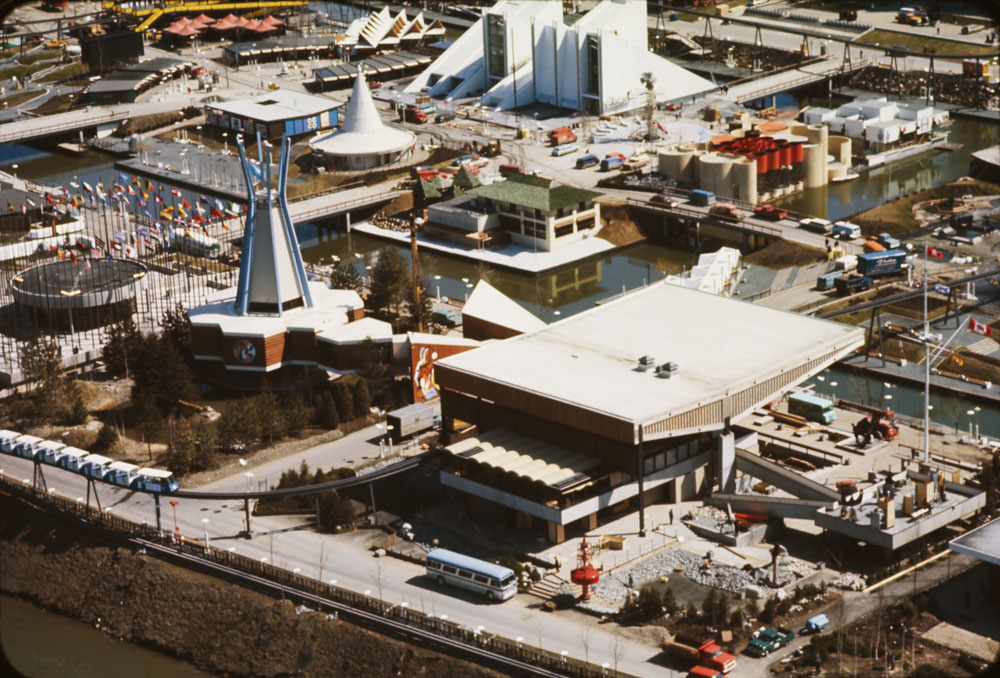
The representation of Indigenous Peoples at world’s fairs has a fraught colonial history. In the nineteenth and earlier twentieth century, displays of and performances by Indigenous Peoples at these events catered to non-Indigenous audiences and served to justify European and North American colonial expansion. At the World’s Columbian Exposition in 1893, a simulated Kwakwaka’wakw village with performers from British Columbia conveyed anthropologists’ notion of Indigenous “authenticity,” which they saw as in need of preservation in the face of settler-colonial influence and cultural genocide. At the same exhibition, and somewhat paradoxically, the United States government had constructed a model boarding school for Indigenous children, demonstrating its nation-wide attempts at the cultural assimilation of Indigenous Peoples.
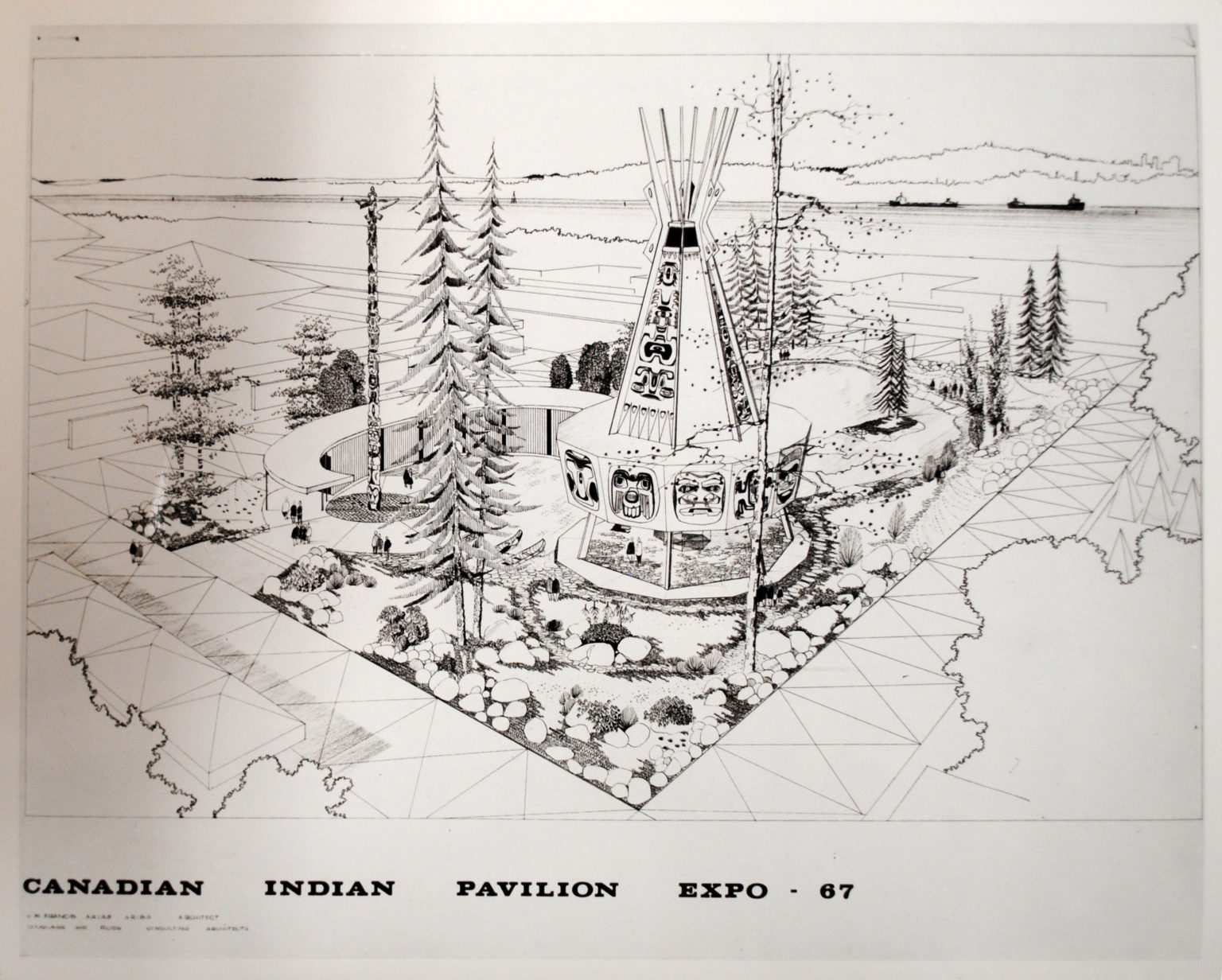
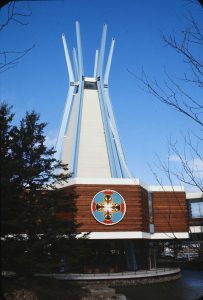
Expo 67 in Montreal was different from earlier fairs and exhibitions in that First Nations took charge of their own representation on the world stage. Although the architecture in many ways continued a colonial narrative (it was designed by a government architect with minimal Indigenous participation), Indigenous creators assumed ultimate control of the pavilion’s message. Artists conceived contemporary works that defied stereotypes and presented a critical—and subversive—narrative of First Nations-state relations. The pavilion can be read as a contact zone between Indigenous and settler-colonial representations, illuminating First Nations’ struggles for sovereignty within the context of Canada’s celebration of nationhood.
The pavilion sat within a lush landscape, complete with a small lake and forest of trees. The plantings represented various geographical regions and included species of significance for Indigenous Peoples. The building’s location between the pavilions of the Atlantic Provinces—part of the Canadian complex—and the United Nations has been interpreted as symbolic of First Nations’ ambiguous position both within and outside the Canadian state.

Approaching the pavilion, Expo-goers climbed three steps up to a paved plaza, in the middle of which stood a totem pole. Three geometric, cedar-clad forms linked by ramps swooped up around the open space (noticeable in the aerial photo). These elements were intended to reference other Indigenous architectural forms, but became abstracted during the design process. They led up to a large “drum,” atop which the tipi was perched. The drum, another reference to diverse Indigenous traditions, was composed of six hexagonal modules that contained exhibition rooms. The tipi motif, though derivative of an architecture common to the Plains, was used to represent First Nations from across Canada—a move reminiscent of the federal government’s categorization of diverse Indigenous Peoples under the single, and now outdated and offensive, label “Indians.” The pavilion’s architect, Joseph W. Francis, described it as follows:
There will be little need, we hope, for our Pavilion to bear a label or sign to identify itself, for its total impression, including the landscape on which it rests, will be unmistakably Indian, but in a curiously contemporary way.[1]
Francis was the chief architect of the Federal Department of Indian Affairs and Northern Development, whose Indian Affairs Branch was the pavilion’s official sponsor. This department had controlled most aspects of First Nations life in the hundred years since Confederation through the Indian Act. From the perspective of Indian Affairs, the pavilion was intended to improve the government’s image with regards to its relationship with First Nations. Yet bureaucrats’ conception of the pavilion remained entrenched in a long history of colonial control. We can see this in Francis’s description of “our” pavilion and his juxtaposition of “Indian” and “contemporary,” casting Indigenous Peoples as both wards of the state and part of the past.
The idea of Indigenous representation at Expo 67—and the Centennial celebrations more broadly—originated in 1963 with the National Indian Council of Canada. Governmental bodies, including the Centennial Commission and Indian Affairs, usurped these efforts, in some cases restricting Indigenous participation to consultation on previously approved projects. For the pavilion, an “Indian Advisory Council” was formed to gather input from across the country, but the architectural design was developed with minimal input from these consultations. Instead, the architect used sketches produced by Indigenous artists invited to a seminar in December 1965 to inform the design. Francis’s aim was to convey the pavilion’s identity without “a label or sign” but directly through the architecture. In taking on this task, however, the architect retained final approval of the design for the government.
Building the pavilion
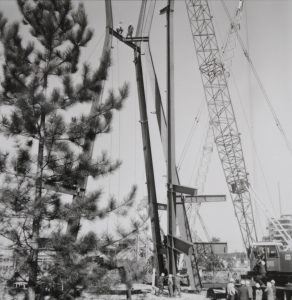
Kanyen’kehà:ka steelworkers from Kahnawá:ke, a community just up the St. Lawrence River from Montreal, have a proud tradition of skilled work on bridges and skyscrapers dating to the nineteenth century. Indian Affairs asked the Dominion Bridge Company to employ these workers on the pavilion’s construction site, with the aim of producing media-worthy photo-opportunities. Images of the steelworkers promoted the idea that the pavilion truly belonged to First Nations—they were building it, after all—while masking the extent of the government’s control over its realization. At the same time, these images document the steelworkers’ genuine contributions to the pavilion, built on a century’s worth of community expertise.
Art as resistance
The artistic program of the Indians of Canada Pavilion was a turning point in the history of contemporary Indigenous art and curation. Several of the participating artists used their work to express political dissent, which countered the control the government had attempted to maintain in earlier parts of the pavilion’s design process. Although the pavilion was groundbreaking in several respects, it was also characterized by gender inequality, as no contemporary women artists were represented. However, First Nations women famously participated as hostesses and some of the unattributed objects displayed inside the pavilion may have been created by women. The artworks on the grounds and exterior of the pavilion were the totem pole, located in the plaza near the entrance; three exterior murals painted directly on the building’s surface; and five circular “panel murals” hung on the bays of the pavilion’s drum. Several of the pieces were bound up with artistic practices of resistance.
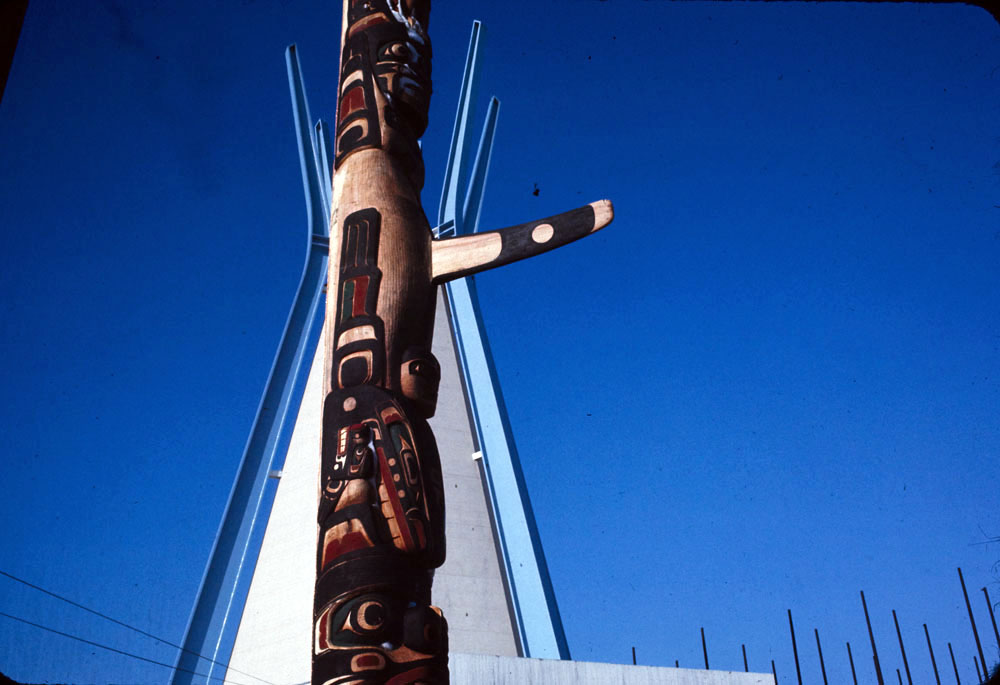
Indian Affairs initially selected Haida artist Bill Reid to complete the totem pole at the pavilion. Reid withdrew from the project because officials wanted a generic pole, not one specific to the Haida Nation, and because of what he viewed as the undignified setting provided by the architect, which he referred to as “Joe Francis’ California style roadside diner teepee.”[2] George Manuel, a Secwépemc member of the pavilion’s Advisory Council, advocated for an open bid process after Reid backed out. Kwakwaka’wakw carvers Henry and Tony Hunt, a father-and-son team, submitted the successful bid. They carved the 21.3-meter-tall pole with Simon Charlie, a Cowichan sculptor trained by the elder Hunt, out of a giant red cedar. The pole is the only element of the pavilion that remains on site today. Painted red, green, and black, with some sections left unpainted, it is composed of six figures.
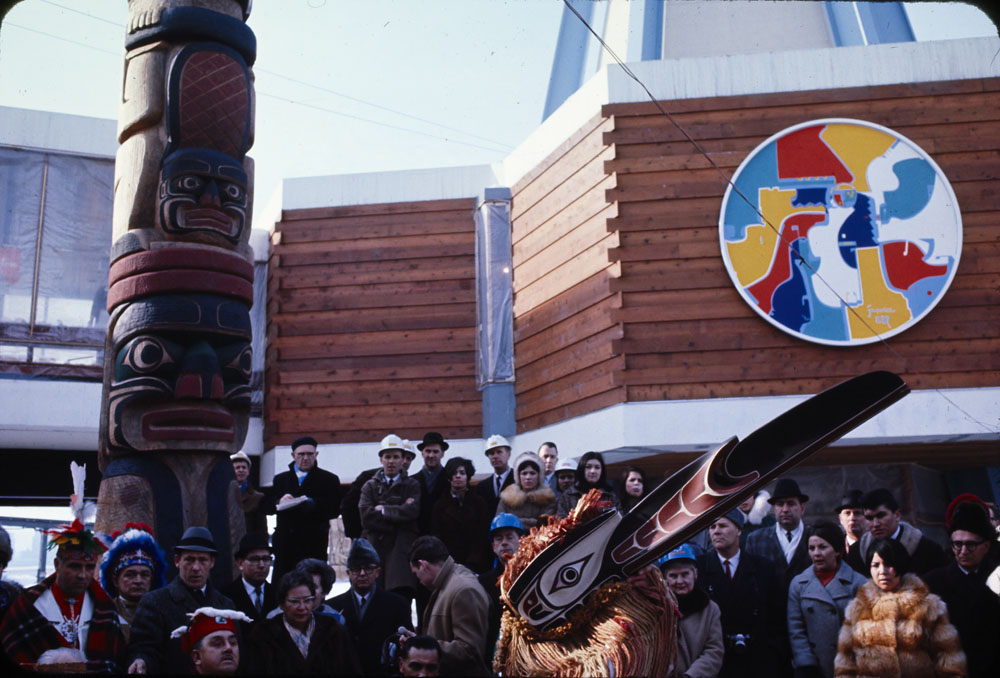
From the bottom, these are Numas (a Kwakwaka’wakw hero), tsawi (beaver), makhinukhw (orca with a seal in its mouth), sisiutl (two-headed serpent), gila (grizzly bear and salmon), and gwa’wis (sea crow). Although the pole refers to Kwakwaka’wakw traditions, it differs from most other poles in that it is not specific to one numaym (house or family) but displays the emblems of a number of houses. Reid’s early protest thus made space for the Hunts to maintain the cultural integrity of their work as they presented it to a global audience.
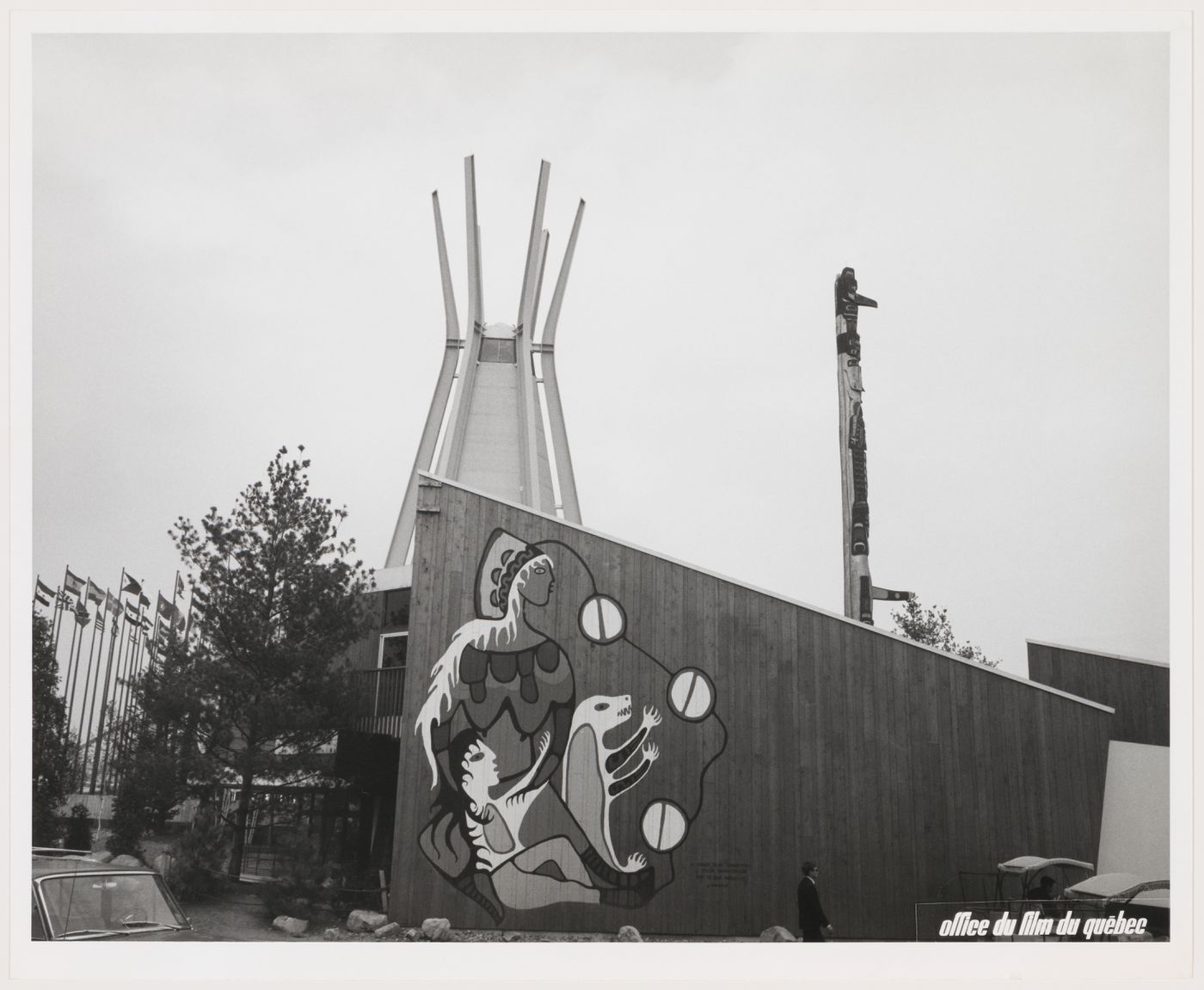
The pavilion featured three prominent murals on its exterior walls. These were Earth Mother with Her Children, by Anishinaabe artist Norval Morrisseau; West Coast, by Tseshaht artist George Clutesi; and The Land, by Anishinaabe artist Francis Kagige. Morrisseau’s mural design depicted a figure with long, white hair and exposed breasts, together with a bear cub and human child, in his signature Woodland style. His original concept for the Expo mural had the cub and child nursing at the Earth Mother’s breast. However, the work was censored by Indian Affairs because they considered the image too explicit for the intended audience. The design was changed to create more distance between the Earth Mother’s breasts and her animal and human children. Morrisseau subsequently left his assistant, Carl Ray, to complete the mural. While he did not abandon the project completely, the artist’s absence from the site has been interpreted as a protest against the government’s meddling in his artistic expression.
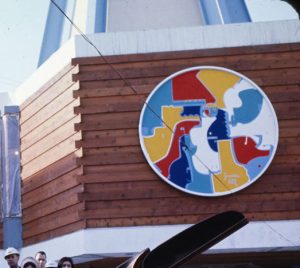
The exterior artwork also included five circular “panel murals,” each nine and a half feet (nearly three meters) in diameter, which were hung on the hexagonal bays that composed the drum at the base of the tipi. The artists of these pieces were Alex Janvier (Denesuline), Noel Wuttunee (Cree), Gerald Tailfeathers (Kainai), Ross Woods (Lakota), Tom Hill (Seneca) and Jean-Marie Gros-Louis (Huron).
Janvier’s piece, The Unpredictable East, was a striking, abstract composition of flowing forms that converged near the center of the circular frame. The forms, some with outlines and some without, were painted with a limited palette of light and dark blue, red, yellow, and white. Some of the shapes met smoothly, while others touched with jagged lines and right angles. The painting’s ironic title was a critique of dictates emanating from Ottawa (Canada’s capital) around what was permissible in the art exhibited at the pavilion. The artist signed the painting with his name as well as his treaty number, 287, a practice of political protest that characterized his work at the time. While The Unpredictable East first appeared at the front of the pavilion, it was later moved to the rear, and Wuttunee’s The Garden of Indians, a seemingly less politically charged piece, took its place (visible in the first photo). The latter painting had a similarly limited palette with swathes of flat color, but a more decorative aesthetic that non-Indigenous audiences may have more readily associated with Indigenous art. The piece was symmetrical in four directions with a floral motif at the center, as well as the side profiles of eight faces. In addition to moving Janvier’s painting, Indian Affairs compelled the artist to change the title, which became the more innocuous Beaver Crossing, Indian Colours.
Inside the pavilion
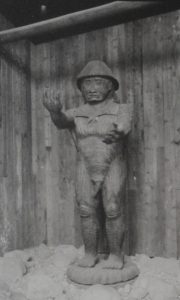
The interior of the pavilion presented a linear narrative of Indigenous history, including life prior to European contact, European arrival and settlement, present conditions, and the future. In the naturally lit reception area immediately inside the entrance was a three-meter-tall welcome figure carved by Simon Charlie, accompanied by a wall text that began, “The Indians of Canada bid you welcome.” The figure, representing a nude male, received guests to the pavilion with a gesture of outstretched arms.

From the reception area, visitors went up through the next section, “The Land” which consisted of a narrow, darkened ramp framed by trees and other plants. This section of the exhibit interpreted Indigenous relationships with the land and included a second mural by Morrisseau, which could be seen through the foliage, as well as a reproduction of a Coast Salish moon mask.
Next came “The Awakening of the People” in a bright, five-sided room that spanned the lake below. This section presented Indigenous Peoples’ adaptation to their environments with photographs and displays of housing and functional objects such as tools and weapons. A short bridge then led into the main exhibits, housed in the six hexagonal bays that surrounded the base of the tipi.
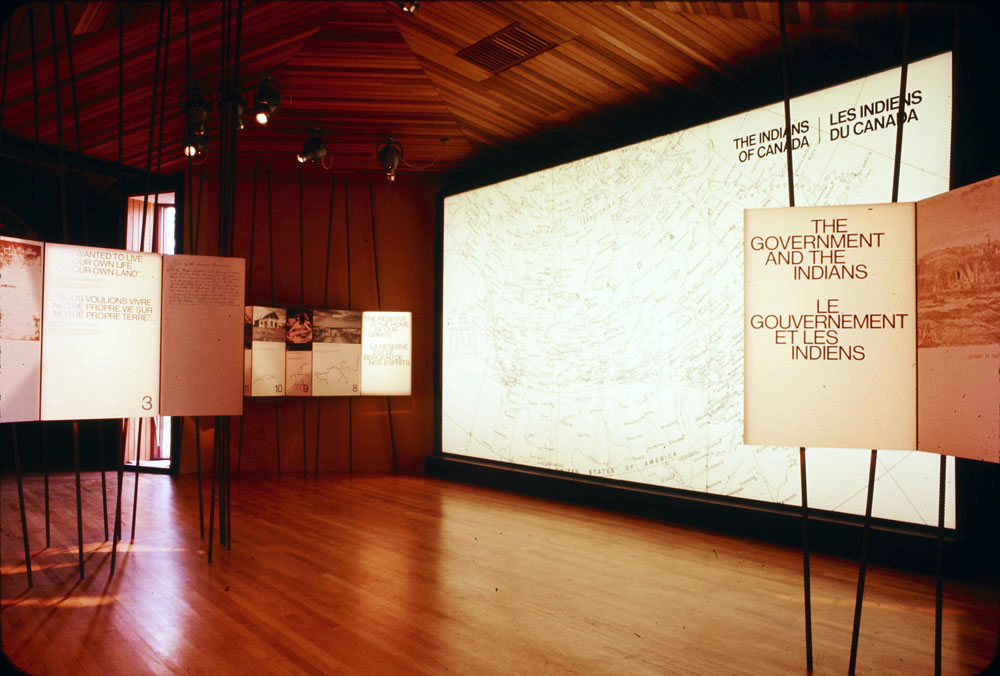
These dealt with First Nations life under settler colonialism, including pointed critiques about broken treaties, Christianity, reserves, poverty, and the residential and day school systems.
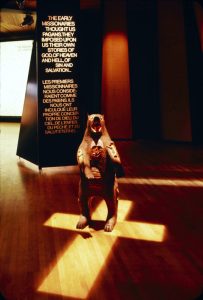
At the center of the exhibit on religion stood Celestial Bear, carved by Delaware artist Nathan Monture. The four-foot-tall (roughly 1.2 meter) bear had an open mouth with a forked tongue, and its body bore various clan symbols. In some photographs, a cross-shaped spotlight can be seen shining on the bear, suggesting the imposition of Christianity upon Indigenous spiritualities. These exhibits formed some of the most controversial aspects of the pavilion due to their condemnation of the government and settler society more generally. Some visitors were shocked and resistant to the critical messaging, while others appreciated the opportunity to learn about the struggles of First Nations from their perspective. Visitors went through these exhibits in a counter-clockwise direction, then descended a flight of stairs back to ground level, where an artificial fire representing “the future” burned under the ceiling of the tipi, illuminated with skylights.
After Expo
World’s fairs are by nature ephemeral. The Indians of Canada Pavilion was designed to be dismantled and rebuilt elsewhere as a community or arts facility. Unfortunately, the site was demolished in 1981. Although it no longer exists, the pavilion remains widely regarded as a prototype for Indigenous curatorial practices, a significant early exhibition of contemporary Indigenous art, and a project that galvanized Indigenous leadership and political activism across the country. It was one of the first opportunities for artists and leaders from diverse communities to come together and present contemporary First Nations art and political issues on the world stage.
Although not free from government interference and gender inequality, the pavilion was a significant moment in Indigenous political activism and artistic production at the end of the 1960s. Considering its architecture, art, and exhibits in tandem, the pavilion represents the tensions and contradictions of First Nations life under settler colonialism as well as the continuity of Indigenous ways of being and knowing, particularly through art practices. As a heterogenous site, the pavilion registered various forms of power and resistance that continue to be relevant today.
About the author
Magdalena Miłosz is an architectural historian and was previously trained as an architect. Her ongoing doctoral research examines the social and political dimensions of the built environment, with a focus on the spatial dynamics of settler colonialism. She has received awards and fellowships from the Social Sciences and Humanities Research Council of Canada, McGill University, Graham Foundation, Canadian Centre for Architecture, Society of Architectural Historians, and Vernacular Architecture Forum. Her writing appears in RACAR: Revue d’art Canadienne/Canadian Art Review, Journal of the Society for the Study of Architecture in Canada, and elsewhere. She currently works with Parks Canada and serves as Vice-President (Membership & Communications) of the Society for the Study of Architecture in Canada.
Further reading
Biesinger, Raymond, and Alex Bozikovic. “Indians of Canada Pavilion, Expo 67.” In 305 Lost Buildings of Canada. Fredericton, NB: Goose Lane Editions, 2022.
Bowen, Leah-Simone, and Falen Johnson. “Why the ‘Indians of Canada Pavilion’ at Expo 67 Still Matters.” CBC Podcasts: The Secret Life of Canada, March 2, 2021.
Brydon, Sherry. “The Indians of Canada Pavilion at Expo 67.” American Indian Art Magazine 22, no. 3 (Summer 1997): 54–63.
Canada News. “Chief Sees Ceremony as Totem-pole Tokenism.” Montreal Gazette, September 7, 2007.
Capela-Laborde, Cécile. “The Indians of Canada Pavilion at Expo 67: An Expression of Colonialism.” Unpublished paper, McGill University, 2010.
“Delaware Carves Celestial Bear.” The Indian News 10, no. 1 (April 1967): 2, 5.
Durand, Guy Sioui. “The Indians of Canada Pavilion.” In In Search of Expo 67, edited by Monika Kin Gagnon and Lesley Johnstone, 122-34. Montreal: McGill-Queen’s University Press, 2020.
Gagnon, Monika Kin, Heather Igloliorte, and John Moses. “More than a Pavilion.” Thinking Out Loud: Expo 67, Concordia University, n.d.
Garneau, David. “From Indian to Indigenous: Temporary Pavilion to Sovereign Display Territories.” In In Search of Expo 67, edited by Monika Kin Gagnon and Lesley Johnstone, 136-46. Montreal: McGill-Queen’s University Press, 2020.
Griffith, Jane. “One Little, Two Little, Three Canadians: The Indians of Canada Pavilion and Public Pedagogy, Expo 1967.” Journal of Canadian Studies 49, no. 2 (Spring 2015): 171–204.
Grussani, Linda, and Ruth B. Phillips. “‘For We Have Waited a Hundred Thousand Years’: The Indians of Canada Pavilion and Indigenous Curatorial Practices.” In Expo 67 and Its World: Staging the Nation in the Crucible of Globalization, edited by Craig Moyes and Steven Paul Palmer. Montreal: McGill-Queen’s University Press, 2022.
Kalin, I. “Indians of Canada.” In Expo ’67: Survey of Building Materials, Systems and Techniques used at the Universal and International Exhibition of 1967, Montreal, Canada, 24-26. Ottawa: Materials Branch, Department of Industry, Trade and Commerce, 1969.
Kicksee, Richard Gordon. “‘Scaled Down to Size’: Contested Liberal Commonsense and the Negotiation of ‘Indian Participation’ in the Canadian Centennial Celebrations and Expo ’67, 1963-1967.” Master’s thesis, Queens University, 1995.
Linklater, Duane. “Earth Mother Hair, Indian Hair, and Earth Mother Eyes, Indian Eyes, Animal Eyes.” In In Search of Expo 67, edited by Monika Kin Gagnon and Lesley Johnstone, 106-11. Montreal: McGill-Queen’s University Press, 2020.
Loft, Steven. “Reflections on 20 Years of Aboriginal Art.” Lecture, University of Victoria, February 8, 2012.
MacGregor, Bob, Jim Robertson, and Velma Robinson. “Expo 67’s Indians of Canada.” Expodition, 1967.
Manuel, George, and Michael Posluns. “The Decade of Consultation.” In The Fourth World: An Indian Reality, 156-80. 1974. Minneapolis, Minnesota: University of Minnesota Press, 2019.
Massicotte, Isabelle. “The Architecture of Expo 67: National Identities and the Signs of Time.” Master’s thesis, Carleton University, 2003.
Myers, Lisa. “Ahzhekewada [Let Us Look Back]—Revisioning the Indians of Canada Pavilion, OCAD University, Toronto, 14–15 October 2011.” Public 23, no. 46 (December 2012): 170–72.
“Pavilion Tells Indians’ Story.” The Indian News 10, no. 1 (April 1967): 1, 4–5.
Phillips, Ruth B., and Sherry Brydon. “‘Arrow of Truth’: The Indians of Canada Pavilion at Expo 67.” In Museum Pieces: Toward the Indigenization of Canadian Museums, edited by Ruth B. Phillips, 27-47. Montreal; Ithaca: McGill-Queen’s University Press, 2011.
Pingeton, Julia. “Indigenous Resistance at Expo 67: A Case Study on the Indians of Canada Pavilion.” Unpublished paper, McGill University, 2018.
Régnier, Michel. Indian Memento. National Film Board of Canada, 1967.
Reuters Limited. “Canada: Ancient Indian Ritual At Expo ’67, 1967.” British Pathé, 1967.
Robertson, Carmen L. “Performing Agency.” In Mythologizing Norval Morrisseau: Art and the Colonial Narrative in the Canadian Media, 77-81. Winnipeg: University of Manitoba Press, 2016.
Rogers, Randal Arthur. “Man and His World: An Indian, a Secretary and a Queer Child. Expo 67 and the Nation in Canada.” Master’s thesis, Concordia University, 1999.
Rutherdale, Myra, and Jim Miller. “‘It’s Our Country’: First Nations’ Participation in the Indian Pavilion at Expo 67.” Journal of the Canadian Historical Association 17, no. 2 (2006): 148–73.
“Totem Kwakiutl.” Bureau d’Art Publique—Ville de Montréal, n.d.
“Work Starts on Expo Indian Pavilion.” The Indian News 9, no. 2 (July 1966): 1, 7.
- Joseph W. Francis, quoted in Ruth B. Phillips and Sherry Brydon, “‘Arrow of Truth’: The Indians of Canada Pavilion at Expo 67,” in Ruth B. Phillips, Museum Pieces: Toward the Indigenization of Canadian Museums (Montreal; Ithaca: McGill-Queen’s University Press, 2011), 322. ↵
- Bill Reid, quoted in Richard Gordon Kicksee, “‘Scaled Down to Size’: Contested Liberal Commonsense and the Negotiation of ‘Indian Participation’ in the Canadian Centennial Celebrations and Expo ’67, 1963–1967,” Master’s thesis, Queen’s University (1995), Appendix B. ↵
Canada’s Centennial was a yearlong celebration in 1967 marking the 100th anniversary of Canadian Confederation.
Decolonization is the undoing of colonialism, as when one country or area ceases to be the colony of another and becomes self-governing or independent. The term may also refer to the process of changing cultural and other aspects of the colonial experience.
A form of colonization that seeks to remove Indigenous populations from their traditional lands and replace them with a new society of settlers.
A tipi is a conical tent used by Indigenous Peoples of the Plains. The structure consists of wood poles arranged on an ovoid or circular plan and coming together at an apex, a cover of tanned hide or canvas, and east-facing smoke flaps and door. The cover is sometimes painted with abstract or figurative art.
A term introduced by literary scholar Mary Louise Pratt in 1991 to denote a social space in which different cultures interact, often under conditions of struggle and unequal power dynamics. The term is now widely used across the humanities.
Confederation refers to the unification of three British North American Provinces—the Province of Canada, Nova Scotia, and New Brunswick—into a single federation known as Canada in 1867.
The Indian Act is a piece of Canadian legislation, first enacted in 1876 and still in force with amendments, that governs First Nations people recognized as “status Indians” or “registered Indians” by the federal government. It regulates identity, band governments, and reserves (lands reserved for First Nations).
The Woodland School, an artistic movement inspired by Norval Morrisseau, blends Anishinaabe imagery and symbolism with bold, curvilinear forms, flat planes of color, and X-ray-style outlines. The movement is associated with many other First Nations artists, notably the “Indian Group of Seven”: Morrisseau, Daphne Odjig, Jackson Beardy, Carl Ray, Joseph Sanchez, Eddy Cobiness and Alex Janvier.
Welcome figures are a traditional form carved by the Coast Salish to welcome guests to their territories. They can be found installed outside of houses, facing in the direction of visitors.
Along with the arrival of Europeans in seventeenth-century North America, Christian missionaries came to convert Indigenous Peoples, despite the latter’s complex and diverse existing spiritual belief systems. Throughout the centuries, Christian religious conversion was bound up with the violent colonization of Indigenous Peoples and their lands, as well as the suppression of traditional spiritualities. Today, Indigenous Peoples have diverse religious affiliations, including Christianity and Indigenous spiritualities.
Residential schools were church-run and government-administered institutions that aimed to assimilate Indigenous children into settler-colonial society by removing them from their families and communities. Day schools were government-run, on-reserve institutions attended by children during the day. Residential and day schools composed segregated, federally administered systems that caused lasting cultural harms and trauma in Indigenous communities. Survivors of both types of institutions have been part of settlement agreements with the federal government to compensate for the harms experienced.

